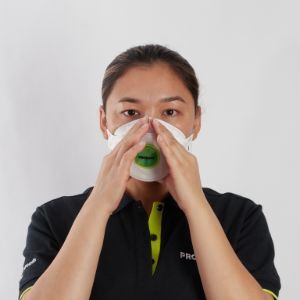P2 trifold respirator: how to correctly fit

Disposable respirators are most effective when there is an airtight seal between the edges of the respirator and your face. The instant this seal is broken, protection is compromised as contaminated air can leak in through any gaps. This also means there is a requirement to be clean-shaven to obtain a good facial seal. Follow these fitting instructions on how to get an effective seal on a trifold respirator.
Before you start
Tie back long hair and remove jewellery so that it does not interfere with the seal to the face. Be clean-shaven. Do not wear with beards or other facial hair that prevents a good seal to the face.

1.
Pre-stretch around entire length of each strap by pulling at 3 cm intervals between both hands.

2.
Ensure both panels are fully unfolded to form a cup shape. Bend slightly at the centre of the nose clip.

3.
With both straps held on the top panel, place opened respirator in one hand against your face, with the nosepiece across the bridge of your nose.

4.
Take both straps in your other hand. Hold the respirator under your chin. Pull the straps over your head.

5.
Pull the top strap, resting it high over the crown of your head. Pull the bottom strap over your head, then position it around your neck and below your ears. Straps must not be twisted. Adjust nose and chin panels for a comfortable fit, ensuring panels are not folded in.

6.
Using both hands, mould nose clip to the shape of your nose bridge by pushing inwards while moving your fingertips down both sides of the nosepiece.

7.
Face Fit Check — every time before entering the hazardous area. Cover front of the respirator with both hands, taking care not to disturb its fit. When using a valved respirator, inhale sharply. The respirator should collapse slightly indicating a proper seal has been obtained. Then work may proceed.

Choosing the right PPE to enhance worker safety
While safety in Australian workplaces has improved over recent years, more can still be done to...
More action needed on workplace lung health, survey finds
Despite stronger crystalline silica protections taking effect from 1 September 2024, a new survey...
Nanofibre uniform protects against chemical hazards
A next-generation uniform prototype has successfully been developed by CSIRO researchers for...







